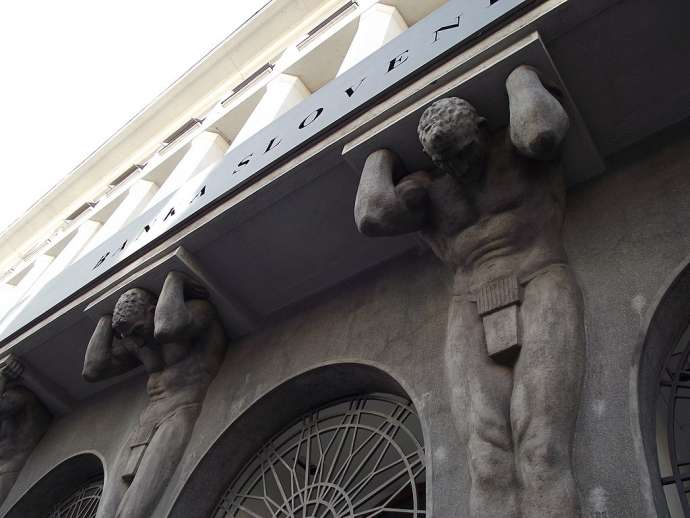STA, 12 January 2019 - The global financial crisis, which erupted in 2008 with the collapse of Lehman Brothers, hit Slovenia with a delay, but it exposed huge weaknesses that had built up in the majority state-owned banking system. By 2012 Slovenia was locked out of financial market, and it took until the bank bailout in late 2013 before the sector recovered.
In the run-up to the crisis, credit growth was buoyant, driven by cheap money after interest rates collapsed following the changeover to the euro in 2007.
Loans to the non-banking sector surged by almost two-thirds between 2006 and 2008. Banks financed the expansion mostly by securing financing from foreign banks.
The crisis thoroughly razed the banking landscape.
Banks' total assets peaked at over EUR 50bn in 2010 before reaching a low of just 37bn six years later.
Related: Economic Crisis that Produced a “Lost Decade” in Slovenia
Similarly, lending contracted by more than a third between 2010 and 2016, as banks deleveraged to pay back their foreign loans rather than extend new loans to Slovenian businesses.
On the other hand, deposits remained robust as households responded to the crisis by tightening spending, which deepened the economic crisis but gave banks a lifeline when foreign financing dried up.
The total volume of loans slipped slightly during the crisis as households drew down their savings, going from EUR 23.9 bn in 2010 to EUR 22.4bn in 2013, but the contraction was never as severe as the tightening of lending.
Bank statistics
Total assets Loans to non-banking sector
(in EUR m) (in EUR m)
2006 34.1 20.6
2007 42.6 28.5
2008 47.9 33.7
2010 50.8 34.7
2013 40.3 24.3
2014 38.7 21.5
2016 37.1 20.5
2018* 38.3 22.2
* As of 31 October
Source: Slovenian central bank
A property bubble that burst in 2010
The credit explosion leading up to the crisis inflated a property bubble, which burst post-2010 as large construction companies that also financed their own projects collapsed one after the other, as did over-leveraged financial holdings.
The share of non-performing loans started to soar, forcing banks to set aside increasing provisions and writing down assets, leading to a negative spiral.
Whereas foreign-owned banks received capital injections from their shareholders, the three biggest banks in the country were all in state ownership, requiring growing amounts of public funds to keep them afloat.
Video: Slovenia's Economic Crisis, 2012
The story came to a head in December 2013, when the treasury spent EUR 3.5bn recapitalising NLB, NKBM and Abanka, wiping out shareholders and junior bondholders in the process. Two smaller banks, Probanka and Factor Banka, were wound down.
At the same time, about four billion euros in non-performing loans were transferred onto the newly-established Bank Assets Management Company (BAMC), which also absorbed the assets of Probanka and Factor Banka.
After the banking system was bailed out banks were flush with cash and largely freed of non-performing loans, but it took several years before lending recovered.
Bank performance
Net profit Net provisions, write-downs
(in EUR m) (in EUR m)
2008 208 -120
2009 162 -279
2010 -99 -811
2013 -3439 -3809
2014 -106 -650
2016 364 -96
2017 443 43
2018* 452 45
* As of 31 October
Source: Slovenian central bank
Lawsuits related to the period
Echoes of this period continue to reverberate five years later, as lawsuits by subordinated bondholders and shareholders wiped out in the bailout make their way through courts.
These investors have targeted in particular the valuations that determined the size of the bailout, alleging that Slovenia had been the target of speculators and a guinea pig for new EU bank resolution rules.
The commotion over the bailout resulted in criminal investigations at the central bank, the resignation of governor Boštjan Jazbec and, recently, criminal charges against the board of governors serving at the time of the bailout.
The costs of the bailout accounted for a significant chunk of the increase in general government debt during the crisis, which ballooned from 22% of GDP in 2008 to almost 84% of GDP by 2015.
The surging debt was accompanied by growing debt servicing costs, as the precarious state of the economy during the crisis led to higher borrowing costs; for a while, Slovenia was practically locked out of the eurobond market and had to borrow in US dollars.
Public debt did not start to decline until 2016, when the economic recovery was already in full swing. In the past two years the treasury has been busy replacing dollar debt with euro bonds and debt has started to decline at a more rapid pace towards the eurozone ceiling of 60% of GDP.
General government finances
Deficit Debt Debt servicing costs
(% of GDP) (% of GDP) (EUR m)
2008 -1.4 21.8 326.1
2009 -5.8 34.6 326.4
2010 -5.6 38.4 476.7
2011 -6.7 46.6 510.6
2012 -4.0 53.8 632.5
2013 -14.7 70.4 827.0
2014 -5.5 80.4 1082.6
2015 -2.8 82.6 1028.8
2016 -1.9 78.7 1064.0
2017 +0.1 74.1 977.3
Source: Eurostat, Statistics Office, Ministry of Finance






